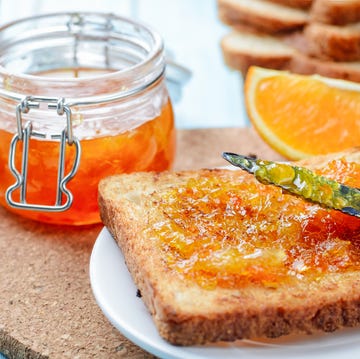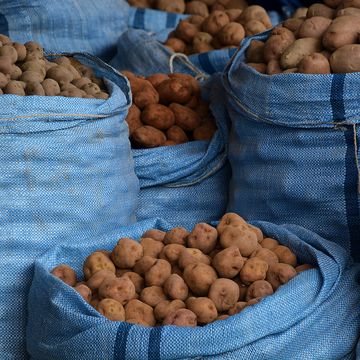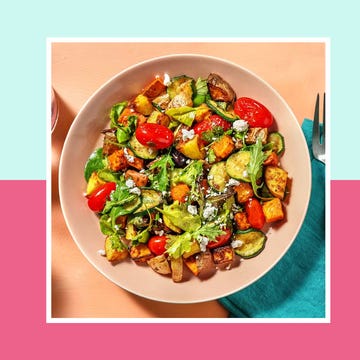What can you do with all those marrows taking up room in your vegetable box? Don't let them go to waste! Whilst marrows sold in shops will be varieties specifically bred for size and storage, realistically it's more likely you were growing regular courgettes and forgot to check a plant just that bit too long and now you have a giant marrow to enjoy.
Whilst technically the same as courgettes, at least botanically speaking, marrows have a less intense flavour due to their large amount of water content (which is also what makes them big) so generally need longer cooking and more intense heat, to concentrate their flavours to make the most of them.
Stuffed marrow
Large marrows make an ideal vessel for a rich and well-flavoured meaty filling, such as a sumptuous bolognese sauce or our super-quick cheat's chilli. If you want to make your own, just be sure to make it flavour-packed - with a tomato-based sauce and lots of herbs and spices (such as parsley, thyme, coriander and chilli) - and try to simmer off most of the excess liquid in the sauce, as the marrow itself has plenty of moisture when cooked.
What to read next
Cut small marrows in half or cut larger marrows into round 3cm-thick slices. Scoop out the seeds, then pack the middles with the cooked filling and roast in the oven until the marrow is tender. About 180°C (160°C fan) mark 4 for 20-30min should do it.
Our favourite bit of kit for preparing large veg like marrows (and also great for things like aubergine and butternut squash) - every kitchen should have one of these:
Roast marrow
Add slices of marrow to other vegetables when roasting, such as carrots, parsnips and beetroot. Cut the marrow in half, then slice and cut into small chunks, drizzle with just a little olive oil, bake for 1hr 15min at 180°C (160°C fan) mark 4 and serve with your Sunday roast. Keep it plain and neutral, or throw in some spices - marrow goes well with bold Indian flavours like cumin, coriander and chilli.
Fried marrow crisps
Peel away the tough outer skin of the marrow with a vegetable peeler, then cut the marrow into thick slices, discarding the seeds. Place in a colander and sprinkle well with salt, leave to drain over a bowl for 30min, then rinse under cold water and pat dry with plenty of kitchen paper. Mix some plain flour with plenty of salt and freshly ground black pepper, and then dust the marrow well in the seasoned flour. Fry the marrow crisps in a deep pan of hot oil for a few seconds until golden, and serve with chopped parsley or mint and a squeeze of lemon juice – perfect as a nibble with cocktails!
Allotment marrow chutney recipe
This is a great way to use up marrows, carrots and windfall apples from the garden or allotment.
Hands-on time: 40min. Cooking time: about 1hr.
Makes about 8 x 500g jars
INGREDIENTS
- 3kg marrow
- 3tbsp salt
- 500g carrots, peeled and chopped
- 500g onions, peeled and chopped
- 500g eating apples, peeled, cored and roughly chopped
- 500g raisins
- 5cm piece fresh root ginger, peeled and finely chopped
- 2tsp coriander seeds
- 2tsp dried red chillies
- 2tsp cumin seeds
- 500g light muscovado sugar
- 1.4 litre malt vinegar
METHOD
1. Peel the marrow and cut into small chunks, discarding the seeds and fibrous core. Place in a bowl with the salt, toss well. Tip into a large colander set over a large bowl (or in the sink) and leave for 12hr or overnight. Drain, rinse and drain again.
2. Place the marrow in a large preserving pan with the remaining ingredients. Bring to the boil, then reduce the heat and simmer until the consistency is thick and most of the liquid has evaporated, and your wooden spoon leaves a clear path for a second or two when scraped through the pan (this will take about an hour or so).
3. Pour the chutney into hot sterilised jars, cover with vinegar-proof lids and store for at least a month before serving.
A crack team of highly skilled food content producers, the GH Kitchen Team are Good Housekeeping’s resident recipe developers and all-round food obsessives. GH Kitchen Director Sarah Akhurst is our resident hosting pro and loves nothing more than putting on a foodie feast for friends. Senior Cookery Writer Alice Shields is a former pastry chef and baking fanatic who loves making bread and would have peanut butter with everything if she could. Lover of all things savoury, Senior Cookery Writer Grace Evans can be found eating nocellara olives at every opportunity, and will take the cheeseboard over dessert any time. With a wealth of professional kitchen experience between them, they’re dedicated to ensuring every Good Housekeeping recipe is the best it can be, so you can trust they’ll work every single time.
















